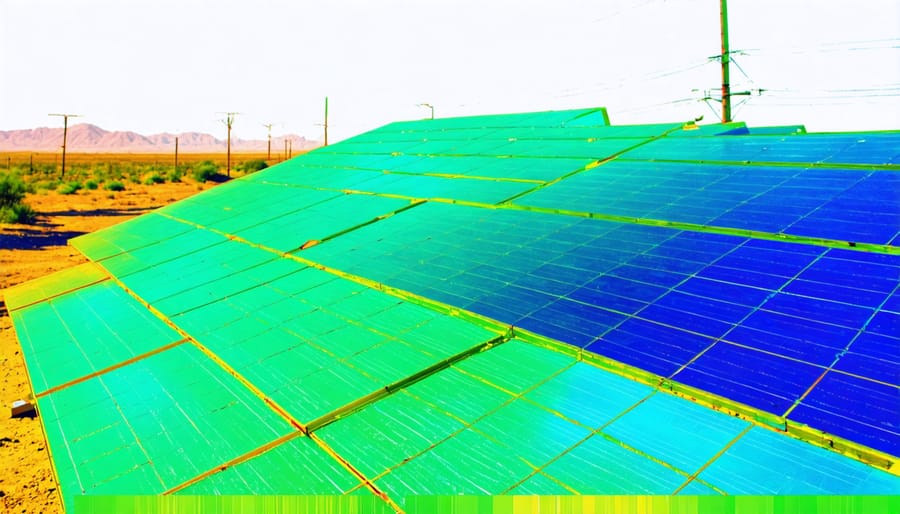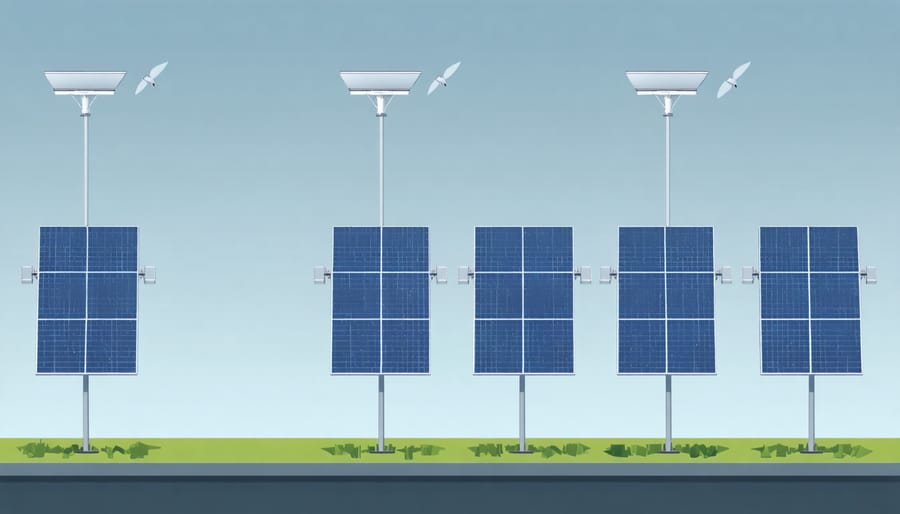Why Desert Solar Lighting Varies (And How to Maximize Your System’s Power)
Solar radiation’s dance across our desert landscapes tells a fascinating story of power, potential, and precision. As our sun delivers varying intensities of energy throughout the day and seasons, these natural fluctuations create both challenges and opportunities for solar energy systems. Desert environments, with their clear skies and intense sunshine, experience some of the most dramatic solar radiation variations on Earth – from scorching midday peaks reaching 1,000+ watts per square meter to gentle morning rays that barely touch 100 watts.
Understanding these variations isn’t just about scientific curiosity – it’s essential for anyone investing in solar technology. Whether you’re a homeowner considering rooftop panels or a business owner planning a commercial installation, these natural patterns directly impact your system’s performance and return on investment. Recent advances in solar tracking technology and smart energy management systems have transformed these variations from potential obstacles into opportunities for optimized energy harvesting.
Let’s explore how these solar radiation patterns shape our renewable energy future and discover practical ways to harness their power effectively.
Desert Solar Radiation: The Basics
Direct vs. Diffuse Radiation in Desert Environments
Desert environments experience two main types of solar radiation: direct and diffuse. Direct radiation is the intense sunlight that travels straight from the sun to the earth’s surface without interference. Think of it as a laser-like beam of sunlight – it’s what creates those sharp shadows on a clear day. In desert regions, direct radiation is particularly strong due to minimal cloud cover and low humidity.
Diffuse radiation, on the other hand, is sunlight that’s been scattered by particles in the atmosphere before reaching the ground. Even on the clearest desert day, about 10-20% of total solar radiation is diffuse. During dust storms or hazy conditions, this percentage can increase significantly.
What makes desert environments unique is their exceptionally high levels of direct radiation compared to other climates. The lack of moisture and clouds means less solar energy gets scattered or absorbed by the atmosphere. This is great news for solar power generation, as direct radiation is typically more efficient for solar panels to convert into electricity. However, the intense direct radiation can also lead to higher surface temperatures, which might slightly reduce solar panel efficiency during peak hours.

Seasonal Solar Intensity Patterns
Desert climates experience distinct patterns of solar radiation throughout the year, with peak intensity occurring during summer months. In these regions, the summer sun stays higher in the sky for longer periods, resulting in more direct sunlight and higher energy yields. During winter, the sun’s path is lower across the horizon, leading to reduced solar intensity despite the typically clear skies.
What makes desert solar patterns unique is the minimal cloud cover and atmospheric interference. This means that even during winter months, desert regions often receive more usable sunlight than other climates do in summer. However, extreme temperature variations between seasons can affect solar panel efficiency, with peak performance typically occurring during cooler, bright winter days rather than intense summer heat.
Understanding these seasonal patterns helps homeowners and businesses optimize their solar installations by adjusting panel angles seasonally and planning for varying energy production throughout the year.
Factors Affecting Desert Solar Radiation
Dust and Atmospheric Particles
Airborne particles, including dust, sand, and pollution, can significantly impact how much solar radiation reaches your solar lighting systems. These tiny particles act like tiny mirrors in the atmosphere, reflecting and scattering sunlight before it reaches your solar panels. Just like solar performance in cloudy conditions, dust accumulation can reduce your system’s efficiency by up to 25%.
In desert environments, where dust storms are common, regular cleaning becomes essential. Even a thin layer of dust can create a barrier between sunlight and your solar cells, reducing their ability to generate power effectively. Urban areas face additional challenges from smog and industrial pollution, which can create a persistent haze that filters out valuable solar energy.
The good news is that most modern solar lighting systems are designed to work efficiently even with some dust accumulation. However, maintaining a regular cleaning schedule and being aware of local air quality conditions can help you maximize your system’s performance. Consider installing automated cleaning systems or scheduling professional maintenance during particularly dusty seasons to keep your solar lights operating at peak efficiency.
Temperature and Heat Effects
Desert temperatures can significantly impact solar panel performance, with both advantages and challenges. While abundant sunlight is excellent for energy generation, extreme heat can actually reduce solar panel efficiency. When temperatures soar above 77°F (25°C), panels typically lose 0.5% efficiency for each degree increase. This means that a panel rated at 20% efficiency might operate at just 15% during peak desert heat.
However, modern solar technology has evolved to better handle these conditions. Today’s solar lighting in extreme heat uses advanced materials and cooling designs to maintain performance. Some panels incorporate reflective coatings and ventilation gaps that help dissipate heat, while others use temperature-resistant materials that perform better in harsh conditions.
The good news is that despite some efficiency loss during the hottest hours, desert solar installations still generate substantial power throughout the day. The extended sunshine hours and intense solar radiation more than compensate for the temperature-related efficiency dip, making desert regions ideal for solar energy harvesting when proper equipment is used.

Optimizing Your Solar Lighting System
Panel Positioning and Tracking
Proper positioning and tracking of your solar panels can significantly boost their energy production. For optimal results, panels should face true south in the Northern Hemisphere (or true north in the Southern Hemisphere) and be tilted at an angle roughly equal to your location’s latitude.
Modern solar installations often incorporate tracking systems, which allow panels to follow the sun’s path throughout the day. Single-axis trackers move east to west, increasing energy production by 25-35%. Dual-axis trackers adjust both horizontally and vertically, potentially boosting output by up to 40%, though they require more maintenance.
For fixed installations, seasonal adjustments can make a big difference. Many homeowners adjust their panels’ tilt angle four times per year: spring equinox (latitude minus 15°), summer solstice (latitude minus 23°), fall equinox (latitude minus 15°), and winter solstice (latitude plus 15°).
Keep panels clear of shade from trees, buildings, or other obstacles, as even partial shade can significantly reduce performance. Regular cleaning is also essential, especially in desert areas where dust accumulation can decrease efficiency by up to 15%.
Consider using a professional solar installer to determine the ideal placement for your specific location. They can account for local factors like weather patterns, surrounding structures, and regional solar radiation patterns to maximize your system’s performance.

Maintenance for Maximum Efficiency
To maintain optimal performance of your solar lighting system, regular maintenance is essential. A well-maintained system can significantly reduce common solar light issues and maximize energy absorption, even during periods of varying solar radiation.
Start with a monthly cleaning routine for your solar panels. Desert environments often mean dust, sand, and debris accumulation, which can reduce efficiency by up to 30%. Use a soft, non-abrasive cloth and mild soap solution to gently clean the panels during early morning or evening hours when they’re cool.
Check the positioning of your solar panels quarterly. Seasonal changes affect the sun’s path, so adjust the tilt angle accordingly to capture maximum sunlight. A general rule is to increase the tilt during winter months and decrease it during summer.
Inspect wiring connections every six months for signs of wear, corrosion, or damage from extreme weather conditions. Loose connections can significantly impact system performance. Also, ensure that surrounding vegetation doesn’t cast shadows on your panels.
Keep a maintenance log to track cleaning dates, angle adjustments, and any performance issues you notice. This documentation helps identify patterns and potential problems before they become serious. For commercial installations, consider professional maintenance services annually to ensure all components are functioning at peak efficiency.
Remember, consistent maintenance not only extends your system’s lifespan but also ensures you get the most value from your solar investment.
Understanding and adapting to solar radiation variations in desert environments is key to maximizing your solar lighting system’s performance. By implementing the strategies we’ve discussed, you can achieve up to 30% better efficiency from your solar installations. Remember to regularly clean your panels, especially during dust storms, and adjust their angles seasonally to capture optimal sunlight.
For best results, monitor your system’s performance through smart tracking devices and schedule maintenance during the cooler morning hours. Consider installing light-colored ground covers around your panels to reduce heat absorption and enhance reflection. These simple yet effective steps can significantly boost your system’s output and longevity.
Looking ahead, emerging technologies like self-cleaning panels and advanced tracking systems are making desert solar installations even more efficient. By staying informed about these innovations and maintaining your current system properly, you’re not just saving on energy costs – you’re contributing to a more sustainable future.
Take action today by implementing these optimization techniques, and you’ll see the difference in both your energy production and utility bills. Remember, successful desert solar lighting is all about working smart with nature’s patterns.








